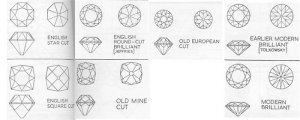So I''m looking at what an antique dealer called an Old Mine Cut (2.04 HSI1,8.14-8.28 X 4.95mm), and he pulls out the GIA Cert and it says Round Brilliant. I could''ve sworn I''ve seen GIA Certs with "OEC" and "Transitional Round Brilliant." Would the GIA say "OMC" if it was the case?
I fully understand that the distinctions among OECs, OMCs TRB''s and "modern" round brilliants are somewhat subtle, but I thought the GIA still reflected the fact that it is an old cut?
This particular diamond had a 59% table, 60% depth, 36 degree crown angle, 41 degree pavillion, extremely thin girdle and medium culet. Good P & S.
Thoughts?
I fully understand that the distinctions among OECs, OMCs TRB''s and "modern" round brilliants are somewhat subtle, but I thought the GIA still reflected the fact that it is an old cut?
This particular diamond had a 59% table, 60% depth, 36 degree crown angle, 41 degree pavillion, extremely thin girdle and medium culet. Good P & S.
Thoughts?








300x240.png)